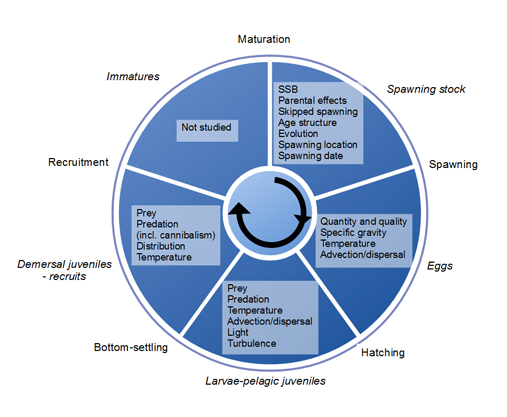The thirty-two articles published in the special issue of ICES Journal of Marine Science cover a rather broad spectrum, from historical facts relating to Hjort, a bibliometric analysis of Hjort's impact on fisheries science through cod recruitment analyses and modelling to management oriented work.
In one of these papers we review the early life history dynamics of Barents Sea cod, currently the world’s largest cod stock. Our focus is on the effects of the biotic and abiotic drivers, which jointly determine the strength of a year class. A stage-by-stage approach is employed. We summarize and assess the significance of the different processes described in the literature to be at play during each specific life stage, from spawning stock, through eggs, larvae, and pelagic juvenile, to demersal juvenile and recruitment at age 3. Also Russian work is included, some of which until now has not been available to non-Russian readers. Physical drivers examined include sea temperature, advection and dispersal, wind-induced turbulence, and light. Biotic mechanisms studied range from maternal effects and skipped spawning in the adult stock through egg quantity and quality, to prey availability for the larvae and effects of cannibalism on the juveniles.

Figure 2. Conceptual Paulik diagram for Barents Sea cod. Factors determining survival from one stage to the next are shown in the sector between them. The diagram should be read clockwise, starting from the Spawning stock, thus following the development life cycle.
Finally, we evaluate the main hypotheses put forth by Johan Hjort a hundred years ago in the light of our synthesis of present knowledge. A main conclusion is that it is unlikely that there is any one single life stage during which recruitment with any generality is determined.
References
Johan Hjort (1914). Fluctuations in the great fisheries of Northern Europe viewed in the light of biological research Rapports et Procès-Verbaux des Réunions, 20, 1-228
Ottersen, G., Bogstad, B., Yaragina, N., Stige, L., Vikebo, F., & Dalpadado, P. (2014). A review of early life history dynamics of Barents Sea cod (Gadus morhua) ICES Journal of Marine Science, 71 (8), 2064-2087 DOI: 10.1093/icesjms/fsu037

Log in to comment
Not UiO or Feide account?
Create a WebID account to comment